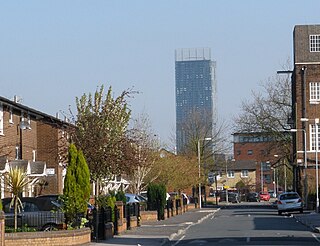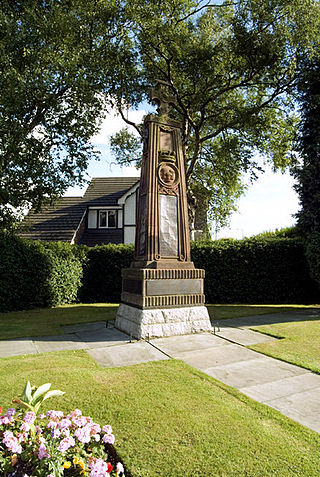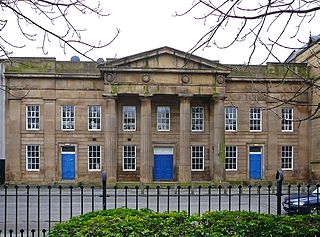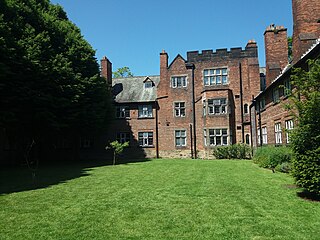This article needs additional citations for verification .(September 2011) |


Victoria Park is a suburban area of Manchester, England. Victoria Park lies approximately two miles south of Manchester city centre, between Rusholme and Longsight.
This article needs additional citations for verification .(September 2011) |


Victoria Park is a suburban area of Manchester, England. Victoria Park lies approximately two miles south of Manchester city centre, between Rusholme and Longsight.
In 1836, a unique enterprise was undertaken by Richard Lane and Partners, architects. This was to establish a residential area to the east of Wilmslow Road, an "estate" of substantial houses in spacious grounds, where prosperous business and professional families could live. Lane was already noted for his public work in the neo-classical style, for example his town hall building at Chorlton on Medlock. The facade of this building remains on the Manchester Metropolitan University All Saints' Campus and formed part of the Mabel Tylecote Building.
The early years of the 'Victoria Park Company' were of mixed fortune. The original plans to develop land in a slightly different area, did not reach complete fruition, largely due to the fraud which led to the Foss v. Harbottle case. A cul-de-sac of villas was built opposite Whitworth Park, and these were later demolished for the construction of the Royal Infirmary. The fraud, or rather a complex connected series of frauds, related to the original development along Moss Lane East. Drainage techniques of the time were insufficient to support the developers' ambitions, and the large tranche of land they owned was not built on until several decades later. Some of the original villas remain on the southern side of Moss Lane East, between Wilmslow Road and Monton Street. They are attractive and spacious buildings.
The focus of the second, successful phase shifted to the better-quality land now known as Victoria Park. Professional people moved into the large houses, and from the earliest days a wide variety of nationalities was represented, notably a wealthy Prussian and Chinese merchant community. It had its own tollgates, walls and police. By 1850 about 50 houses by various architects had been built. Some villas and the sedate atmosphere of the area began to change at the beginning of the 20th century. After a long period of social disintegration, which began as early as 1920, the area has become more established and is now made up of a mixture of university residences, and rented and private accommodation. In March 1972, Manchester City Council designated a Conservation Area in Victoria Park. [1]
The area has over 20 listed buildings and among its many significant buildings is the notable Grade I listed First Church of Christ, Scientist (now the Edgar Wood Centre) in Daisy Bank Road, the work of the Middleton architect Edgar Wood. Also of significance are Summerville on Daisy Bank Road; Hirstwood by Edward Salomons; Alfred Waterhouse's Xaverian College; and St Chrysostom's Church, the Anglican parish church designed by George T Redmayne at the corner of Oxford Place and Anson Road. St Chrysostom's Church backs onto the University of Manchester's Dalton-Ellis Hall, one of the older halls of residence at the university of Manchester Redmayne was the architect of the original Dalton Hall.
The Chinese Consulate-General is also located in a large mansion in Victoria Park, as is that of Pakistan.
Victoria Park Campus of the university comprises several halls of residence. Among these are Hulme Hall (including Burkhardt House), St Anselm Hall with Canterbury Court, Dalton-Ellis Hall, the former St Gabriel's Hall and Opal Gardens Hall. Hulme Hall contains grade II listed buildings designed by Percy Worthington in the arts and crafts style, and is the oldest hall of residence for the university, having opened in 1887 and moved to Victoria Park in 1907. [2]
A church was included in the line drawings issued by Lane in 1836. The building was started in the 1840s but was abandoned because the Victoria Park Company went bankrupt. Victoria Park was from 1850 included in the parish of St James, Birch, until 1878, when the new parish of St John Chrysostom was created from parts of the parish of St James and other parishes.

Rusholme is an area of Manchester, England, two miles south of the city centre. The population of the ward at the 2011 census was 13,643. Rusholme is bounded by Chorlton-on-Medlock to the north, Victoria Park and Longsight to the east, Fallowfield to the south and Moss Side to the west. It has a large student population, with several student halls and many students renting terraced houses, and suburban houses towards Victoria Park.

Withington is a suburb of Manchester, Greater Manchester, England. Historically part of Lancashire, it lies 4 miles (6.4 km) from Manchester city centre, about 0.4 miles (0.6 km) south of Fallowfield, 0.5 miles (0.8 km) north-east of Didsbury and also 1 mile (1.6 km) east of Chorlton-cum-Hardy. Withington has a population of just over 14,000 people, reducing at the 2011 census to 13,422.

Wilmslow Road is a major road in Manchester, England, running from Parrs Wood northwards to Rusholme. There it becomes Oxford Road and the name changes again to Oxford Street when it crosses the River Medlock and reaches the city centre.

Fallowfield is a suburb of Manchester, England, with a population at the 2011 census of 15,211. Historically in Lancashire, it lies 3 miles (5 km) south of Manchester city centre and is bisected east–west by Wilbraham Road and north–south by Wilmslow Road. The former Fallowfield Loop railway line, now a shared use path, follows a route nearly parallel with the east–west main road.

Moss Side is an inner-city area of Manchester, England, 1.9 miles (3.1 km) south of the city centre, It had a population of 20,745 at the 2021 census. Moss Side is bounded by Hulme to the north, Chorlton-on-Medlock, Rusholme and Fallowfield to the east, Whalley Range to the south, and Old Trafford to the west.

Bramhall is an area in the Metropolitan Borough of Stockport, Greater Manchester, England. Historically in Cheshire, it had a population of 17,436 at the 2011 Census.

Cheadle Hulme is a suburb in the Metropolitan Borough of Stockport, Greater Manchester, England,. Historically in Cheshire, it is 2 miles (3.2 km) south-west of Stockport and 8 miles (12.9 km) south-east of Manchester. It lies in the Ladybrook Valley, on the Cheshire Plain, and the drift consists mostly of boulder clay, sands and gravels. In 2011, it had a population of 26,479.

Chorlton-on-Medlock is an inner city area of Manchester, England.

Hulme is an inner city area and electoral ward of Manchester, England, immediately south of Manchester city centre. It has a significant industrial heritage.

Dalton-Ellis Hall is a hall of residence complex at the University of Manchester in Manchester, England. It is situated in the south of the city on Conyngham Road in Victoria Park, next to St Chrysostom's Church. It is close to Wilmslow Road in Rusholme. Dalton-Ellis has 279 male and female residents in catered accommodation. The hall admits both undergraduate and postgraduate students; most are undergraduate first years.

Handforth is a town and civil parish in Cheshire, England, 9 miles (14 km) south of Manchester city centre. The population at the 2011 census was 6,266. In the 1960s and 1970s, two overspill housing estates, Spath Lane in Handforth, and Colshaw Farm nearby in Wilmslow, were built to re-house people from inner city Manchester. It lies between Wilmslow, Heald Green, Stanley Green and Styal and forms part of the Greater Manchester Built-up Area.

The architecture of Manchester demonstrates a rich variety of architectural styles. The city is a product of the Industrial Revolution and is known as the first modern, industrial city. Manchester is noted for its warehouses, railway viaducts, cotton mills and canals – remnants of its past when the city produced and traded goods. Manchester has minimal Georgian or medieval architecture to speak of and consequently has a vast array of 19th and early 20th-century architecture styles; examples include Palazzo, Neo-Gothic, Venetian Gothic, Edwardian baroque, Art Nouveau, Art Deco and the Neo-Classical.

Saint Chrysostom's Church is the parish church in Victoria Park, Manchester, England. The church is of the Anglo-Catholic tradition, and also has a strong tradition of being inclusive and welcoming.

Richard Lane was an English architect of the early and mid-19th century. Born in London and based in Manchester, he was known mainly for his restrained and austere Greek-inspired classicism. He also designed a few buildings – mainly churches – in the Gothic style. He planned and designed many of the houses in the exclusive Victoria Park estate.

Hulme Hall is a traditional University of Manchester hall of residence situated at the Victoria Park Campus in Rusholme, Manchester, housing 300 students. It has a range of facilities including the John Hartshorne Centre: a 300 seat lecture theatre with attached seminar rooms; a library; Junior Common Room and study spaces; music room; old dining hall; the Victoria Park bar; and chapel.

Holy Trinity Platt Church, is in Platt Fields Park in Rusholme, Manchester, England. It is an active Anglican parish church in the deanery of Hulme, the archdeaconry of Manchester, and the diocese of Manchester. The church is recorded in the National Heritage List for England as a designated Grade II* listed building. It is the second "pot church" designed by Edmund Sharpe, so-called because the main building material used in the construction of the church is terracotta.

Chorlton Poor Law Union was founded in January 1837 in response to the Poor Law Amendment Act 1834, also known as the New Poor Law. It was overseen by an elected board of 19 guardians representing the 12 parishes in the area it served: Ardwick, Burnage, Chorlton-upon-Medlock, Chorlton with Hardy, Didsbury, Gorton, Hulme, Levenshulme, Moss Side, Rusholme, Stretford, and Withington, all in present day south Manchester, England.
George Tunstal Redmayne, more usually G T Redmayne, was the youngest of four sons of Giles Redmayne and his wife, Margareta Robey. He was born in London and attended Tonbridge School for two years before being educated by private tutors. His father was a wealthy linen draper and silk mercer who owned a house in London and Brathay Hall in the Lake District where he employed architect Alfred Waterhouse in the mid-1850s. George Redmayne became Waterhouse's pupil in 1859 and remained with him as his assistant. He married Waterhouse's sister, Katherine, in 1870 and they had two sons, Martin, in 1871, and Leonard, in 1877. Redmayne died at his residence, Great Stoakley in Haselmere, in 1912.
Manchester is a city in Northwest England. The M14 postcode area is to the south of the city centre, and contains the areas of Fallowfield, Moss Side, and Rusholme. The postcode area contains 59 listed buildings that are recorded in the National Heritage List for England. Of these, one is listed at Grade I, the highest of the three grades, three are at Grade II*, the middle grade, and the others are at Grade II, the lowest grade.